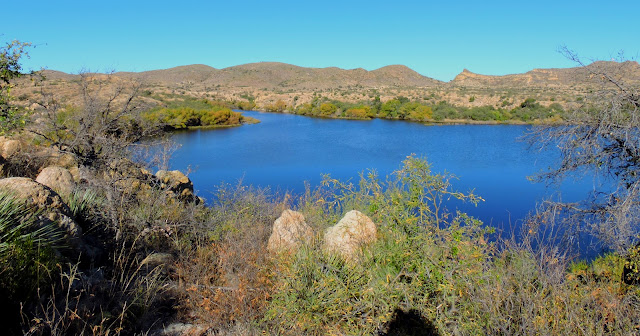Hotspot Highlight: Arivaca Lake
By Brian Nicholas
 |
| Northern section of lake, Brian Nicholas |
Arivaca Lake is the hottest hotspot you probably haven’t visited recently, or ever. In eBird, it has the 4th highest species total of any hotspot in Pima County, a feat accomplished with under 900 checklists. In 2021 Arivaca Lake recorded 216 species, more than ANY other eBird hotspot in Pima County! This was accomplished with around 300 checklists, less than one per day. Imagine what could be discovered if birders visited this area more frequently!
I focus on Arivaca Lake for one reason: potential. At an impressive 90 acres of water it dwarfs all other lakes in Pima county. Because of its large size it’s more likely to attract and hold species that prefer large bodies of water, such as gulls, terns, jaegers, scoters, boobys, loons, and grebes. I believe that Arivaca Lake could produce the next new species to Pima County’s overall bird list. The best time to search this lake for that rare new gull, grebe, booby, or loon is now.
I bird Arivaca Lake because on each visit there is a good chance to add something new to the hotspot list or to my own personal list. In 2021, I recorded 199 species for my year list with only 122 checklists. There are only 3 hotspots in the county where you can reach 200 personal species for the year and Arivaca Lake is at the top of that list. Exciting birds this year included a Least Tern, four Elegant Terns, two American White Pelicans, and the very cooperative and continuing Green Kingfisher. The latter species is a mega-rarity in Pima County, the first one seen since 2008!
 |
| Green Kingfisher by Brian Nicholas |
 |
| American White Pelican and Great Blue Heron by Mick Thompson |
Kayaking or canoeing this gem is the best way to access some of the more distant coves. Avid hikers may enjoy the challenge of hiking around the lake and exploring the rich habitats extending out from the finger-like coves. The five mile hike feels like six or seven due to the loose rock and thorny understory, but the views are breathtaking and there’s a greater chance of stumbling upon a nice rarity.
Below is a list of some of the more birdy sections of the lake. Use this MAP as a reference.
- The northern main body of the lake. A Bald Eagle, Common Loons, and a Horned Grebe were seen in this area in 2020 and a Least Tern stopped by this year. Best viewed from map lookout points four and 12.
- The shoreline areas left and right of the parking area. Many birds will come in for drinks just right of the parking lot and you may find a foraging flock.
- Bartolo Cove: This cove is east over the hill from the parking area and is where the Green Kingfisher has been seen regularly. The area usually has some waterfowl and outstanding shorebird habitat. Upland species like Arizona Woodpecker can also be seen here. Best views are from map areas 20 and 13.
- Behind the dam: This area has a lot of sparrows including Swamp and Clay-colored. Tree species include ash, cottonwood, mesquite, and hackberry. A marshy area also has potential.
 |
| Bartolo Cove shorebird habitat |
 |
| Bartolo Canyon |
Arivaca Lake has so much potential due to its size, diverse vegetation, mid level elevation, and shorebird friendly mud flats. It is a 90 plus acre oasis surrounded by desert grassland and mountains. It has all the makings of a great birding location except one, birders! I hope you give this hotspot a good effort this year. I can’t wait to hear what you find!
 Brian
Nicholas is a birding enthusiast who has lived in Tucson for about 20
years. His primary focus has been birding his neighborhood in Northeast
Tucson, where he has seen around 250 species. Brian is a long-time
volunteer for Tucson Audubon as an Important Bird Areas bird surveyor
and field trip leader.
Brian
Nicholas is a birding enthusiast who has lived in Tucson for about 20
years. His primary focus has been birding his neighborhood in Northeast
Tucson, where he has seen around 250 species. Brian is a long-time
volunteer for Tucson Audubon as an Important Bird Areas bird surveyor
and field trip leader.
Comments
Post a Comment
Thanks, we value your opinions! Your comment will be reviewed before being published.